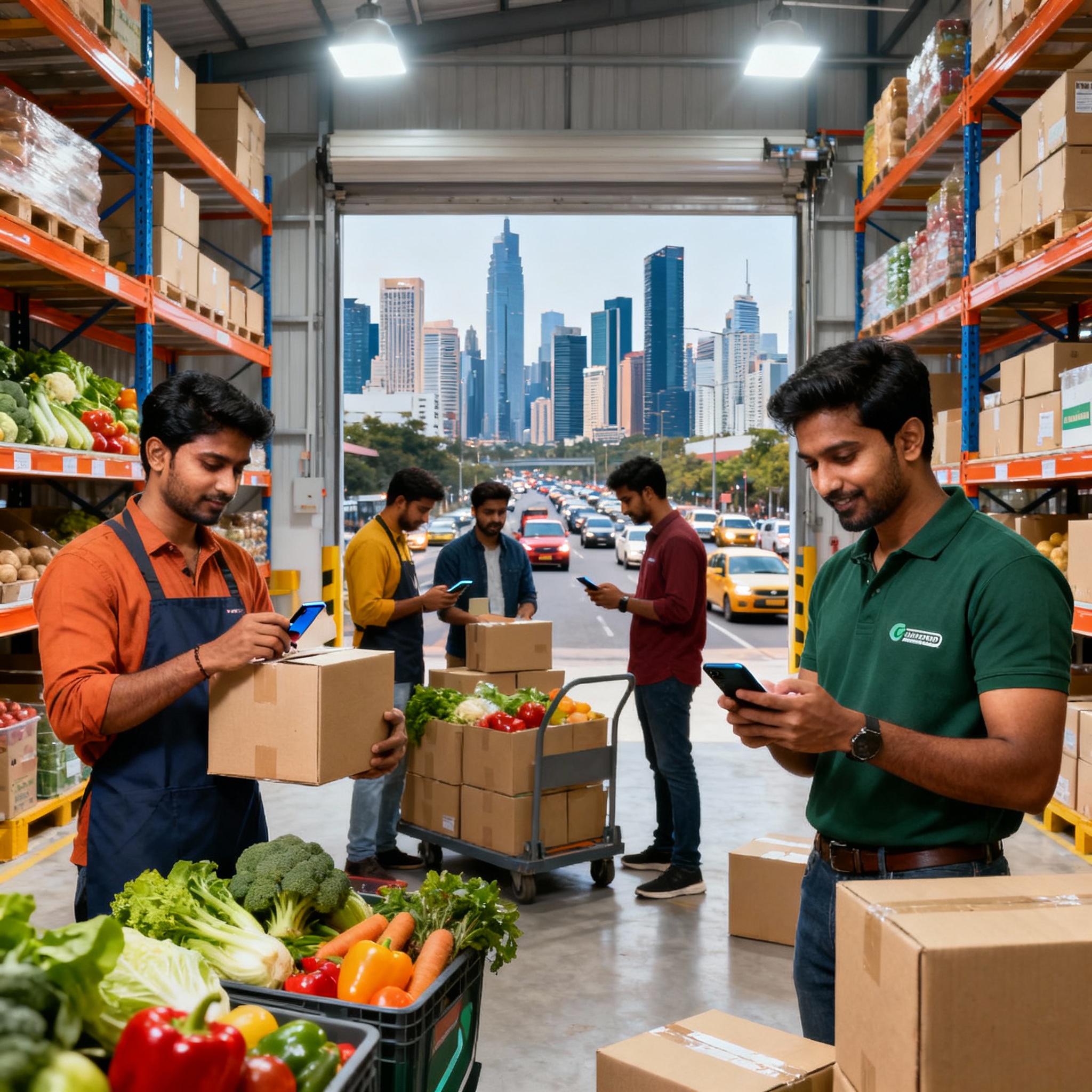In 2021, a revolution quietly began in a Mumbai apartment. Aadit Palicha and Kaivalya Vohra—two ambitious Stanford dropouts—looked at India’s grocery delivery struggle and decided it was time for something radically faster. They started with ₹5,000, a WhatsApp group, and a belief: what if you could get groceries delivered in just 10 minutes? This question sparked a journey that transformed how millions shop, shattered industry norms, and shook even global giants in the quick commerce space.
The Founders: Roots of Ambition
Aadit and Kaivalya’s friendship goes back to childhood. Both were raised in Mumbai, breathing the city’s energy. Academic achievers, they headed to Stanford, but the pandemic pulled them back. In India, they found the online grocery experience broken—long waits, unreliable delivery, and frustrated customers everywhere.
“The problem was everywhere. My mom ordered tomatoes and got them two days later. Sometimes, not at all,” Aadit recalls. Kaivalya and Aadit knew something had to change.
They started with the basics. No big team, no infrastructure—just a WhatsApp group connecting neighbors with local stores. From these humble beginnings, their entrepreneurial fire grew.
The Spark: KiranaKart and the Birth of Zepto
Before Zepto, there was KiranaKart. The founders tried partnering with local kirana (corner) stores to offer fast grocery delivery. The idea was solid, but execution proved tough. KiranaKart could deliver in 45 minutes—better than most, but not groundbreaking.
Instead of giving up, Aadit and Kaivalya saw a bigger vision. What if they owned the process end-to-end? A rebrand was born. In 2021, Zepto emerged, named to convey “speed and smallness,” inspired by the metric unit.
Building Zepto: Execution over Ideas
Zepto’s killer advantage was its network of dark stores—mini warehouses tucked inside city neighborhoods. These stores stocked popular essentials and were endlessly optimized for speed. Orders were routed to the nearest dark store and packed within minutes.
“The 10-minute promise was bold. We wanted to make the point that speed is possible, and customers deserve it,” Kaivalya explains.
But building this network wasn’t easy. Early struggles included:
-
Convincing landlords to rent space for tiny, windowless warehouses
-
Recruiting staff willing to move at lightning speed
-
Fine-tuning logistics algorithms to keep inventory accurate and routes optimal
-
Competing with established giants like BigBasket and Swiggy Instamart
Early Days: Scrappy Hustle and Relentless Experimentation
Zepto’s team was tiny but ferociously driven. Aadit recalls days when he personally packed orders, delivered groceries, handled customer complaints, and coded the app—all while living on a tight budget. Mistakes happened daily, but each was a chance to learn and improve.
Hiring was a challenge too. The team hunted for “missionaries, not mercenaries”—people who believed in the speed revolution, not just a paycheck.
Every rupee was precious. Marketing was mostly word-of-mouth. A single viral video showing Zepto’s delivery in under 10 minutes brought thousands of first-time users. The company doubled down on customer feedback, relentlessly analyzing order data to refine their systems.
Funding and Growth: The First Big Break
As Zepto scaled, venture capital took notice. The startup raised seed funding from Y Combinator, StepStone Group, and Goodwater Capital. Despite their youth, the founders earned investor trust through their grit and data-centric execution. By 2024, Zepto had raised over $1.95 billion, with a $5 billion valuation.
With fresh funds, Zepto accelerated expansion across 11 major Indian cities, from Mumbai to Delhi to Bangalore. The “10-minute delivery” became a phenomenon—customers shared screenshots, posted delivery speed records, and the brand soared in popularity among young, tech-savvy urbanites.
The 10-Minute Revolution: How Zepto Changed Shopping Forever
Zepto’s success hinged on its hyperlocal logistics model. The company didn’t just promise fast delivery—it engineered it at every level:
-
Dark stores placed at strategic points slashed delivery distances (average: just 1.8 km)
-
AI-powered route optimization and inventory management kept everything running smoothly
-
Partnerships with local suppliers ensured fresh products, minimized stockouts
Customers no longer had to plan ahead or make weekly lists. Need eggs at midnight? Zepto delivered. Forgot milk for morning tea? Sorted, in ten minutes or less.
The ripple effect extended to competitors. Swiggy Instamart, Blinkit, and BigBasket ramped up their own quick-commerce efforts. QSR chains (Quick Service Restaurants) started copying Zepto’s instant delivery model for ready-to-eat foods.
Viral Moments and Key Milestones
Zepto’s journey was peppered with impactful moments:
-
Going viral on social media: Delivery riders filmed speed runs, joyful customers posted reviews, and Zepto’s memes trended nationwide.
-
User numbers soared: By late 2025, Zepto processed over 1.5 million orders daily and operated 250+ dark stores.
-
Membership program launch: In 2024, Zepto introduced paid memberships, racking up over 4 million subscribers in just a few months.
-
Zepto Café and Bloom: Side divisions experimented with hot foods and farm-to-city produce delivery, though the focus quickly returned to grocery speed and reliability.
-
Operational excellence: Zepto built a high-performance culture, emphasizing data, efficiency, and trust.
Struggles, Lessons, and Resilience
Growth was not without challenges. Zepto faced:
-
Heavy operational costs: Running hundreds of dark stores with real-time inventory is expensive. Every minute shaved off delivery times raised the stakes.
-
Competition pressure: Rivals copied Zepto’s model, leading to an arms race in speed and service.
-
Scaling logistics: Handling millions of orders meant tech upgrades, workforce expansion, and non-stop process fixes.
-
Criticism and learning: Zepto’s ambitious culture drew scrutiny; the founders addressed concerns while maintaining their high standards.
Through it all, Aadit and Kaivalya stayed hands-on with every aspect of the business. They emphasized transparency, open data, and humility even as Zepto grew into a unicorn.
Impact on the Indian Market and Beyond
Zepto’s story inspired a new wave of Indian founders. It proved:
-
Small beginnings can spark huge change.
-
Tech and logistics—done right—can revolutionize daily life.
-
Indian consumers are ready for new experiences when execution matches ambition.
Zepto’s rise is reshaping grocery shopping, influencing food delivery, and prompting improvements even in traditional retail. The quick commerce boom means more convenience, more choices, and stiffer competition, all thanks to a startup born from a ₹5,000 idea.
Today and What’s Next
Today, Zepto is a household name in urban India. The brand is expanding into more cities, experimenting with partnerships, and constantly improving its tech backbone.
Future plans include:
-
Increasing the network of dark stores to cover more towns and semi-urban areas
-
Expanding product range—beyond groceries to everyday essentials and emergency items
-
Investing in advanced AI for even faster, smarter order management
-
Building better customer support, empowering gig workers, and exploring sustainable logistics
Aadit and Kaivalya reflect: “This started as a small experiment. Every day, we remember why we built Zepto—to make daily life easier, faster, and stress-free.”
Founder Insights and Advice
Aadit shares:
“Start with a clear problem. Ask yourself, would your solution make life better for people around you? Don’t be afraid to hustle, fail, and improve. Listen to your users—they know what’s broken better than anyone.”
Kaivalya adds:
“Speed is not just about delivery. It’s fixing mistakes fast, responding quickly to feedback, never sitting idle. And always, always keep your team motivated.”




